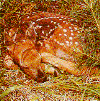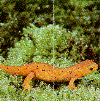



Please be careful as you drive through New Hampshire; the white tail deer, the state’s animal, often makes appearances on our roadways. The ladybug, became New Hampshire’s state insect, in 1977. How this came about is interesting; read about it below. And, below you will find information on the state’s amphibian, butterfly, dog, and saltwater game fish.

State Animal
The white tail deer is hereby designated as the official state animal of New Hampshire.
The white tail deer, also known as the Virginia deer was named the state animal in 1983. The deer is common to North America.
Source: New Hampshire Revised Statutes Annotated (RSA) 3:12

State Insect
The ladybug, also known as the ladybird and the lady beetle, is hereby designated as the official state insect of New Hampshire.
Ladybug Wins State Crown. The 1977 Legislature voted the ladybug as New Hampshire’s official state insect, in a history-making manner. The House of Representatives reversed an adverse committee recommendation on a ladybug bill, with a 185 to 135 standing endorsement. And then the Senate gave the measure such enthusiastic approval that all 24 members signed a copy of the bill, which was framed and presented to the Broken Gound grammar school of Concord, whose pupils sponsored the idea.
It was the boys and girls of Grade 5 of the school who launched the ladybug project, out of their social studies, before the 1977 legislators. They had studied it the previous year, according to Mrs. Marilyn A. Fraser, their teacher, and developed lobbying plans to woo support of the incoming lawmakers. Details of this successful sponsorship of a new law by a group of school children are without precedent. First off, they turned to the two legislators of their East Concord district, Representatives Polly B. Johnson and Robert J. Watson, to sponsor their ladybug bill. They also collected the signatures of 100 citizens and other classmates, to support their venture.
Surprising House Manipulations. The ladybug flitted into strange House manipulations. When its bill was filed on February 3, Speaker George B. Roberts, Jr., surprised observers by referring it to the Committee on Claims, Military and Veterans Affairs. Following a customary public hearing on what became House Bill 259, Irvin H. Gordon of Marlborough, committee clerk, announced one of the most unusual recommendations in legislative history. It read:
The committee was most favorably impressed with the enthusiasm, intelligence and research done by the members of the 5th grade of the Broken Ground School of Concord, and with the merits and capabilities of the "ladybug."
With such an important consideration as the adoption of a state insect, the committee felt it appropriate to recommend the appointment of a "State Insect Selection Board," so as to broaden the scope of the search for a state insect by hearing from other groups, who may champion other beneficial insects. The ladybug is already the state insect of at least three other states. The amendment establishes such a Board, consisting of one Representative, one Senator, two members appointed by the Governor and Council, chaired by the state entomologist.
The strange committee recommendation went before the House on March 3, and was approved by the legislators, without discussion. But then Ednapearl Parr of Hampton, a committee member, challenged the approval vote, took the floor to argue for passage of HB 259 in its original form, and demanded a showdown standing vote.
Chairman Richardson D. Benton (of Chester) of the CMVA committee spoke against Mrs. Parr's demand for reconsideration. So did Ashton J. Norton of Hampton, a committee member, and Elaine T. Lyons of Merrimack. Mrs. Johnson and Francis A. Dostilio of Keene joined in the reconsideration maneuver, whereupon Speaker Roberts put it to vote, and the ladybug bill was resurrected by a decisive 185 to 135 division tally.
Mabel Richardson of Randolph next moved that the ladybug bill be "tabled," which meant indefinite postponement, and she was shouted down. Finally, George A. Barrus, Cornish farmer and lay clergyman, called for formal approval of the ladybug, and the bill was passed and sent to the Senate for concurrence.
Flattering Senate Approval. The ladybug, sometimes called the ladybird, was given flattering Senate endorsement. Senator Mary Louise Hancock of Concord became a prime sponsor in the upper branch, as Mrs. Johnson won the support of the New Hampshire Federation of Garden Clubs for the ladybug.
President Alf E. Jacobson referred the ladybug to the Senate Committee on Environmental Control, and its chairman, Phyllis M. Keeney of Hudson promptly got in touch with the Broken Ground School Sponsors for a friendly hearing on their proposal. The committee then filed an "ought to pass" recommendation on April 6, whereupon the Senate gave the ladybug its unanimous approval.
On April 12, the Senate was informed that HB 259 had been enrolled in permanent form and sent to Governor Meldrim Thomson, Jr., for his signature. He signed the ladybug into law on April 15, to become effective 60 days later, which fell on June 14, the annual national Flag Day anniversary.
As the ladybug became New Hampshire’s official state insect; research disclosed that Massachusetts, Ohio, and Tennessee had already adopted the ladybug as their state insects.
In an unprecedented legislative compliment, Senator Hancock induced her 23 Senate associates to join with her in attaching their signatures to a copy of the ladybug bill, whereupon she had it framed and presented to the young sponsors for permanent display in their school.
The ladybug is a tiny, multi-colored, fast-flitting insect, which was described by its sponsors as shaped "like half of a pea, and often having red, white and yellow spots. Ladybugs feed chiefly on plant lice and scale insects. For this reason, fruit growers find ladybugs helpful." The pupils also testified that the ladybug is a sign of good luck, and that most folks are always careful not to harm one.
Sources: New Hampshire Revised Statute (RSA) 3:11; Anderson, Leon. History. Manual for the General Court 1981.

State Amphibian
The spotted newt, Notophthalmus viridescens, is hereby designated as the official state amphibian of New Hampshire.
The spotted newt was designated the state amphibian in 1985 after a two year effort by high school students. Newts are very common to the region. The Union Leader newspaper (April 25, 1985, p48) lists the newts as the "perfect symbol for ensuring ecology in New Hampshire as they exist predominantly in the rain and runoff sodden areas heavily affected by acid rain."
Source: New Hampshire Revised Statutes Annotated (RSA) 3:16

State Dog
The Chinook is hereby designated as the official state dog of New Hampshire.
The Chinook, a sled and work dog, is the only breed to have originated in New Hampshire and one of the few created in America. The breed was started by Arthur Walden in Wonalancet NH in 1917.
The bill was the idea of a group of seventh graders at the Ross A. Lurgio Middle School in Bedford.
Source: New Hampshire Revised Statutes Annotated (RSA) 3:25
State Butterfly
The Karner Blue, Lycaeides melissa, subspecies samuelis, is hereby designated as the official state butterfly of New Hampshire.
1992 saw the designation of an official state butterfly. The Karner Blue butterfly is also known as the Melissa Blue. It is found in small isolated colonies in New Hampshire and elsewhere
Sources: New Hampshire Revised Statutes Annotated (RSA) 3:18; Opler, Paul A. Butterflies East of the Great Plains: An Illustrated Natural History p.120.
State Saltwater Game Fish
The striped bass, Roccus saxatilis, was designated the official state saltwater game fish in 1994.
Source: New Hampshire Revised Statutes Annotated (RSA) 3:19
State Freshwater Fish
The Brook trout, Salvelinus fontinalis, is New Hampshire’s official freshwater fish.
Source: New Hampshire Revised Statutes Annotated (RSA) 3:20
The New Hampshire Almanac is compiled by the New Hampshire State Library from state statutes and other sources as noted.
NH.gov - The Official Web Portal of the State of New Hampshire